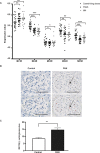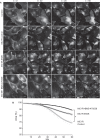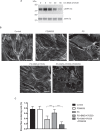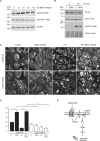Amplification of the Melanocortin-1 Receptor in Nephrotic Syndrome Identifies a Target for Podocyte Cytoskeleton Stabilization
- PMID: 30356069
- PMCID: PMC6200758
- DOI: 10.1038/s41598-018-34004-7
Amplification of the Melanocortin-1 Receptor in Nephrotic Syndrome Identifies a Target for Podocyte Cytoskeleton Stabilization
Abstract
The melanocortin-1 receptor (MC1R) in podocytes has been suggested as the mediator of the ACTH renoprotective effect in patients with nephrotic syndrome with the mechanism of action beeing stabilization of the podocyte actin cytoskeleton. To understand how melanocortin receptors are regulated in nephrotic syndrome and how they are involved in restoration of filtration barrier function, melanocortin receptor expression was evaluated in patients and a rat model of nephrotic syndrome in combination with cell culture analysis. Phosphoproteomics was applied and identified MC1R pathways confirmed using biochemical analysis. We found that glomerular MC1R expression was increased in nephrotic syndrome, both in humans and in a rat model. A MC1R agonist protected podocytes from protamine sulfate induced stress fiber loss with the top ranked phoshoproteomic MC1R activated pathway beeing actin cytoskeleton signaling. Actin stabilization through the MC1R consisted of ERK1/2 dependent phosphorylation and inactivation of EGFR signaling with stabilization of synaptopodin and stressfibers in podocytes. These results further explain how patients with nephrotic syndrome show responsiveness to MC1R receptor activation by decreasing EGFR signaling and as a consequence restore filtration barrier function by stabilizing the podocyte actin cytoskeleton.
Conflict of interest statement
The authors declare no competing interests.
Figures







Similar articles
-
Melanocortin therapy ameliorates podocytopathy and proteinuria in experimental focal segmental glomerulosclerosis involving a podocyte specific non-MC1R-mediated melanocortinergic signaling.Clin Sci (Lond). 2020 Apr 17;134(7):695-710. doi: 10.1042/CS20200016. Clin Sci (Lond). 2020. PMID: 32167144 Free PMC article.
-
Melanocortin 1 receptor agonist protects podocytes through catalase and RhoA activation.Am J Physiol Renal Physiol. 2016 May 1;310(9):F846-56. doi: 10.1152/ajprenal.00231.2015. Epub 2016 Feb 17. Am J Physiol Renal Physiol. 2016. PMID: 26887829
-
Podocyte-associated talin1 is critical for glomerular filtration barrier maintenance.J Clin Invest. 2014 Mar;124(3):1098-113. doi: 10.1172/JCI69778. Epub 2014 Feb 17. J Clin Invest. 2014. PMID: 24531545 Free PMC article.
-
Calcium, TRPC channels, and regulation of the actin cytoskeleton in podocytes: towards a future of targeted therapies.Pediatr Nephrol. 2016 Jul;31(7):1047-54. doi: 10.1007/s00467-015-3224-1. Epub 2015 Oct 21. Pediatr Nephrol. 2016. PMID: 26490951 Free PMC article. Review.
-
Genetics of nephrotic syndrome: new insights into molecules acting at the glomerular filtration barrier.J Mol Med (Berl). 2009 Sep;87(9):849-57. doi: 10.1007/s00109-009-0505-9. Epub 2009 Aug 1. J Mol Med (Berl). 2009. PMID: 19649571 Review.
Cited by
-
Repository Corticotropin in Treating de novo C3 Glomerulonephritis after Transplantation.Glomerular Dis. 2021 Oct 22;2(2):100-105. doi: 10.1159/000520387. eCollection 2022 Apr. Glomerular Dis. 2021. PMID: 36751532 Free PMC article.
-
Pharmacological Melanocortin 5 Receptor Activation Attenuates Glomerular Injury and Proteinuria in Rats With Puromycin Aminonucleoside Nephrosis.Front Physiol. 2022 Jun 1;13:887641. doi: 10.3389/fphys.2022.887641. eCollection 2022. Front Physiol. 2022. PMID: 35721571 Free PMC article.
-
Cytoskeleton Rearrangement in Podocytopathies: An Update.Int J Mol Sci. 2024 Jan 4;25(1):647. doi: 10.3390/ijms25010647. Int J Mol Sci. 2024. PMID: 38203817 Free PMC article. Review.
-
Melanocortin therapy ameliorates podocytopathy and proteinuria in experimental focal segmental glomerulosclerosis involving a podocyte specific non-MC1R-mediated melanocortinergic signaling.Clin Sci (Lond). 2020 Apr 17;134(7):695-710. doi: 10.1042/CS20200016. Clin Sci (Lond). 2020. PMID: 32167144 Free PMC article.
-
Repository corticotropin injection versus corticosteroids for protection against renal damage in a focal segmental glomerulosclerosis rodent model.BMC Nephrol. 2020 Jun 15;21(1):226. doi: 10.1186/s12882-020-01879-6. BMC Nephrol. 2020. PMID: 32539845 Free PMC article.
References
Publication types
MeSH terms
Substances
LinkOut - more resources
Full Text Sources
Molecular Biology Databases
Research Materials
Miscellaneous

